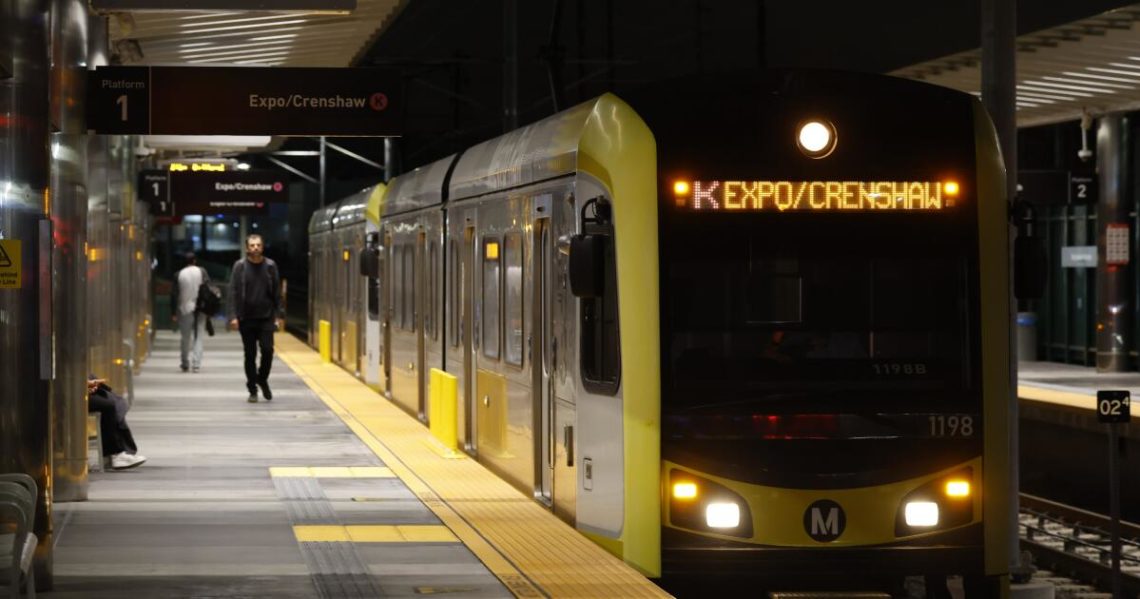When Brendon Gerisch and his wife searched for a new home, they knew they wanted something with a little privacy — a backyard, some fully grown trees, less crowded surroundings.
The couple thought they found their “forever home” in L.A.’s Westchester neighborhood, buying a four-bedroom in 2018 on a quiet street with one-story houses.
Now, he’s not so sure. Landmark legislation now on Gov. Gavin Newsom’s desk would “upzone” his and scores of other neighborhoods across California, allowing the construction of residential buildings as tall as nine stories, depending on how close they are to a rail station.
Senate Bill 79, one of the most significant pieces of housing legislation in decades, seeks to address the state’s housing crisis by boosting production near public transit stops — mostly rail, but also some buses — in Southern California, Sacramento and the San Francisco Bay Area. Newsom has not yet announced whether he will sign the bill.
But the scramble is already on as homeowners, real estate developers, renters’ rights groups and even politicians try to figure out how SB 79, and the sweeping increase in real estate development that it promises, would affect their homes, neighborhoods and cities.
Gerisch, a 46-year-old sales executive, isn’t sure whether he and his family will stay put. SB 79 would allow five-story residential buildings on his and other nearby streets, which sit within a half mile of a Metro K Line light rail station.
“I feel like I’ve been blindsided,” he said. “A lot of us were.”
Under SB 79, developers would be permitted to build up to nine-story residential buildings adjacent to subway stops, seven stories within a quarter mile of them and six stories within a half-mile of them — overriding local planning and zoning rules.
The bill would also allow residential buildings that reach five to eight stories near light rail and dedicated bus lanes, depending on how close a piece of property is to a particular station or bus stop.
To know whether a piece of property might be covered by SB 79, supporters and opponents started by drawing a half-mile radius around subway stations, light rail platforms and dedicated busway stops.
But SB 79 is also loaded up with exemptions, deferrals and carve-outs, some of them the product of the scramble to eke out the votes, complicating the effort to understand the bill’s impact.
Some critics are up in arms over what they call the “Beverly Hills carve-out.” In the final days of the legislative session, backers of the bill scaled back the amount of land targeted by SB 79 in cities with a population below 35,000, such as Beverly Hills and South Pasadena.
In addition, SB 79 would not apply to apartment buildings with three or more units if they are regulated by a city or county’s rent stabilization ordinance, which places limits on yearly rent increases. That provision was added to reduce the potential for displacement of renters.
Cities can also seek a delay in the implementation of SB 79 for properties located in very high fire hazard severity zones, whose boundaries are established by the California Department of Forestry and Fire Protection.
The complex web of rules and exceptions has made it extraordinarily difficult for the average citizen to know which properties will ultimately be covered by SB 79 and which will not, said Cindy Chvatal, a co-founder of United Neighbors, a statewide coalition of community groups that fiercely oppose the bill.
“[State lawmakers] have an obligation to let their citizens and constituents know the impacts of a bill before it passes,” she said. “They never came up with a map before they voted. And we still don’t have an accurate map right now.”
Erik Mebust, spokesperson for state Sen. Scott Wiener (D-San Francisco), a fierce champion of the bill, pushed back on those assertions, saying his office showed legislators maps “at various points” in the deliberations.
“We gave our best approximation to the lawmakers, and they made their decision,” he said.
Mebust acknowledged that SB 79 has been “incredibly challenging to visualize.” For example, he said, a city can exempt a particular property that is half a mile from a transit station as the crow flies, but has physical barriers — railroad tracks, freeways — that actually make it more than a mile away on foot.
In Los Angeles, planning officials recently published a draft map showing the places that they believe would be upzoned under SB 79. But they cautioned that the online tool is for “exploratory purposes only” — and that a binding eligibility map will eventually be published by the Southern California Assn. of Governments.
Supporters of SB 79 said they would have preferred to see it apply to a much greater number of transit stops, and more quickly. But the compromises that scaled it back are the reason the bill passed, they said.
“SB 79 passed by the skin of its teeth,” said Leora Tanjuatco Ross, California director for YIMBY Action, which helped push the bill through the Legislature. “This is the most aggressive bill we could’ve passed.”
SB 79, introduced earlier this year, applies only to counties with at least 15 passenger rail stations. That amendment instantly narrowed the bill’s scope from 58 counties to just eight: Los Angeles, Orange, San Diego, Alameda, San Francisco, San Mateo, Santa Clara and Sacramento.
The biggest impact will probably be felt in Los Angeles, which has an estimated 150 transit stops covered by the bill, according to the city’s preliminary assessment.
In the San Fernando Valley, SB 79 would bring much taller, denser apartment buildings to neighborhoods near the G Line, previously known as the Orange Line busway. It would likely upzone single-family neighborhoods in Arleta, Panorama City and other communities that abut a north-south rail line being built along Van Nuys Boulevard.
On the Westside, the bill would upzone areas not just around the Metro D Line subway, but also bus rapid transit stops planned between Venice and the Los Angeles International Airport, according to the city’s draft map. Beyond that, the bill targets existing or future transit stops in Hollywood, South L.A., the Eastside and other locations, the city’s analysis states.
Matt Lewis, a spokesperson for California YIMBY, one of the bill’s sponsors, said he empathizes with homeowners wishing their neighborhoods would stay the same. But he argued that the issues SB 79 seeks to address — climate change and a housing crisis — are far more urgent worries.
“If your home is close to a transit stop, you’re getting exclusive access to a publicly funded amenity that needs to be accessible to more people,” he said. “The only way to get that access is building more houses by transit stops.”
The move to override local zoning has infuriated many city leaders in Southern California, where single-family housing and car-oriented lifestyles have reigned for decades. In Los Angeles, some said they already submitted a detailed plan for housing production — one that worked with, not against, local communities.
In August, the L.A. City Council passed a resolution opposing SB 79, calling it “chaos” and a “one-size-fits-all mandate.” Mayor Karen Bass asked Newsom to veto the bill.
While the bill was being debated, lawmakers added four deferral options, allowing cities to postpone implementation in selected areas until approximately 2030 — one year after they must submit their latest plan for spurring new housing construction and accommodating growth.
In the wake of the devastating Palisades and Eaton fires, lawmakers were hesitant to add high-density housing to high-risk fire areas. To assuage their fears, legislators added an amendment allowing cities to exempt those areas in the state’s very high fire hazard severity zones until about 2030.
“We believe that there’s a safe way to build in fire zones,” said Ross, the California director of YIMBY Action. “And we’re giving very high fire risk areas a few more years to figure it out.”
SB 79 allows the state to upzone historic districts, paving the way for the demolition of well-preserved Victorian houses, Arts and Crafts bungalows and Spanish Colonial Revival homes. However, the bill’s authors gave communities the option to seek a five-year delay for those properties as well.
In the run-up to the final vote, the bill’s sponsors also attempted to address the concerns of lawmakers who represent smaller cities. That led to the decision to shrink SB 79 zones to a quarter mile in cities with less than 35,000 residents, compared with a half mile everywhere else.
After that change was made, state Sen. Sasha Renée Pérez — who represents South Pasadena, with a population of about 25,000 — voted yes, saying the population amendment, plus the historic district deferrals and flexibility for cities, earned her support. State Sen. Ben Allen, who represents Beverly Hills, did not record a vote. He told The Times he had concerns over the lack of guardrails for gentrification and displacement.
As a result, SB 79 now targets a quarter-mile area around transit-adjacent properties in South Pasadena, which has a single Metro A Line station, but a half mile in its adjacent communities — Pasadena and L.A.’s Highland Park neighborhood.
The same approach is playing out on the Westside.
In L.A.’s Beverly Grove neighborhood, SB 79 would cover properties that sit within a half mile of the Metro D Line subway. However, in Beverly Hills, right next door, the upzoning bill targets areas within a quarter mile.
Los Angeles City Councilmember Katy Yaroslavsky, who voted to oppose SB 79 and represents Beverly Grove, voiced frustration with that arrangement.
“Sacramento keeps passing one-size-fits-all land use bills with political carve-outs to get votes,” she said in a statement. “The result is that Beverly Hills gets off the hook, and Los Angeles is left holding the bag. It’s unfair and bad policy.”
Lewis, the California YIMBY spokesperson, said the carve-out for smaller cities was one of several changes necessary to secure the bill’s passage.
“We got the votes. That’s what matters,” he said.
Mebust, the Wiener spokesperson, declined to comment on the rationale for the Beverly Hills carve-out. He provided a statement from his boss, saying SB 79 was written “with the full range of California’s geographic diversity in mind.”
“SB 79 thoughtfully phases in full implementation — for example, taking into account areas already upzoned around transit — and gives cities significant latitude to craft alternative plans that work for their local communities,” said Wiener, a longtime advocate for increased housing production.
Under SB 79, “low-resource” neighborhoods — areas typically marked by higher levels of poverty — also would have the opportunity to secure a delay. However, cities would need to show that those areas can still accommodate a certain amount of new housing to be eligible.
Those measures have not reassured some renters’ rights advocates, who have been trying to understand the bill’s impacts on the Eastside, the Valley and South L.A.
Larry Gross, executive director of the Coalition for Economic Survival, said he fears developers will use the law to demolish rent-controlled duplexes, replacing them with more expensive apartment projects. If Newsom signs the bill, the city will need to identify how many of those exist near each transit stop, he said.
“I don’t think people knew what the hell they were voting for,” Gross said. “The loss of more rent-controlled housing is not going to solve our housing crisis. It’s just going to exacerbate it.”
The post A historic housing bill is on Newsom’s desk. Cities are scrambling to figure out how it works appeared first on Los Angeles Times.




